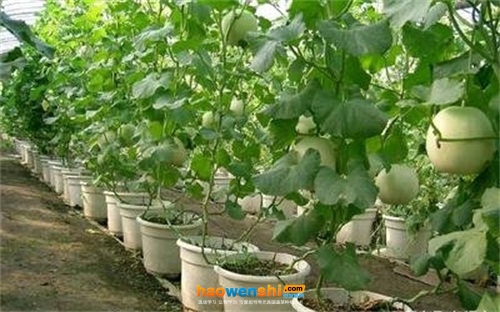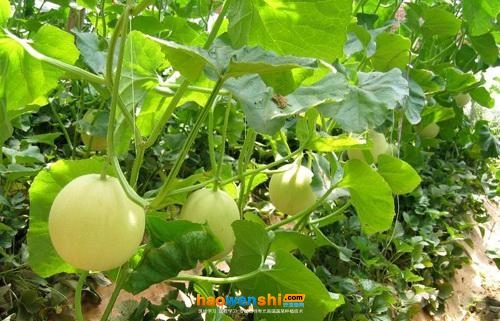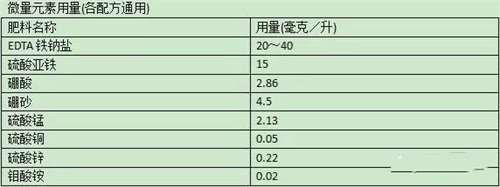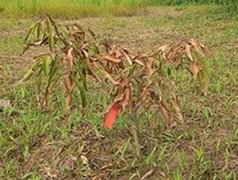Melon planting techniques and management knowledge, detailed explanation of muskmelon soilless cultivation techniques
The main producing areas of our country are Xinjiang, Gansu and other northwest regions. In recent years, the southeast transplanting exploration of muskmelon has been carried out in the eastern and southern provinces of China, such as Guangdong, Guangxi, Hainan, Shanghai, Fujian, Zhejiang, Nanjing and so on. Now it has become an important crop to achieve better economic benefits by soilless cultivation in the south of China. As the supreme cultivation of muskmelon, mainly thick-skinned muskmelon, including reticulated and non-reticulated net types. Muskmelon cultivated in Youtu has the advantages of good quality, high unit price, short growth period and fast running speed of facilities, so it is a treasure of raw melon.
Melon, also known as cantaloupe, belongs to the family Cucurbitaceae. It has two ecological groups: thick skin and thin skin. Melon has good color, aroma and taste, and its sugar content is higher than that of watermelon, and some varieties are as high as 18%. Melons contain aromatic substances and a variety of vitamins and minerals, which are beneficial to human health. Muskmelon is cultivated with soilless culture, can be produced year-round and can be supplied in four seasons. The cultivation methods are mainly rock wool, followed by sand culture, water culture, gravel culture, vermiculite culture and so on.

Soilless cultivation of muskmelon
I. Biological characteristics
1. Botanical characteristics
The root system of muskmelon is well developed, and the main root groups are distributed in the range of underground 15~25cm, which has strong drought tolerance, but the ability of root regeneration is weak, so it is not suitable for transplantation. The stem is trailing, which can produce more son and grandson vines. Simple leaves alternate, orbicular or reniform. Thick-skinned muskmelon has larger leaves than thin-skinned muskmelon, with light and flat leaves. The flowers are monoecious, the male flowers are unisexual, and most of the varieties are female bisexual flowers. Corolla yellow bell-shaped. The fruit is a bottle gourd, which is developed from the receptacle and ovary. The seeds are milky white or yellow, long ovate, 1000-grain weight thin-skinned muskmelon 1520g, thick-skinned muskmelon 3060g.
2. Birth cycle
Germination period: about 10 days from sowing to the appearance of the first true leaf. Seedling stage: from the first true leaf to the fifth true leaf, about 25 days. Trailing period: the fifth true leaf appeared to the first female flower blooming, about 25 days. Fruit setting period: from the opening of the first female flower to fruit maturity, early-maturing variety 20-40 d, late-maturing variety 70-80 d.
3. Requirements for environmental conditions
(1) temperature muskmelon likes temperature, is heat-resistant and is extremely intolerant to cold. It dies in case of frost. When the temperature drops to 10 ℃, it stops growing. The optimum temperature for seed germination was 2535 ℃, and the fastest germination was about 30 ℃. The suitable temperature for seedling stage and stem and leaf growth is 25-30 ℃ in day and 16-18 ℃ at night. The optimum temperature in flowering and fruiting stage is 25 ℃ ~ 30 ℃ in daytime and 15 ~ 18 ℃ at night.
(2) Light muskmelon is a light-loving crop, which usually requires long light for 10 to 12 hours. The light compensation point is 4000lx and the saturation point is 55000lx.
(3) Water melons like drying, which requires low relative humidity, and it is best if the relative humidity is less than 50%. During the fruit expansion period, the moisture in the soil should not be too low, so as not to affect the fruit expansion. During the fruit ripening period, the soil moisture should be low, but not too low, otherwise fruit cracking is easy to occur.
(4) the root system of muskmelon requires aerated and permeable soil, and sandy loam is the best. The suitable pH is 6-7. The ratio of N, P, K to N, P, K for each 1000kg fruit production is 2. 5, 3. 5 kg, P2O5 1. 7 kg, K2O 4. 4, 6. 8 kg, N, P, K is 2, 1, 3. 7.
II. Cultivation season and variety selection
1. Cultivation season
In the south and north of China, spring and autumn cultivation can be carried out generally, and early or autumn cultivation can be carried out according to the regional climatic conditions. The north can also add a crop of summer cultivation, if there are heating conditions, you can also add a crop of overwintering cultivation.
2. Variety selection

Muskmelon
Soilless cultivation should focus on the production of high-quality and high-grade muskmelon. In addition to focusing on quality selection, special attention should be paid to the disease resistance of varieties.
III. Cultivation methods
Muskmelon soilless culture can be cultivated by water culture (nutrient solution) and substrate. The management technology of substrate culture is easier than that of hydroponic culture, and the effect of muskmelon substrate cultivation is better by using brick trough type, bag type, pot type and so on. The technology of compound substrate trough culture of muskmelon is mainly introduced below.
Fourth, the cultivation technique of composite matrix trough
1. Raising seedlings
The seedlings were raised in a nutrition bowl. Soak the selected seeds in warm soup for 4 hours, then disinfect them with 0.1% potassium permanganate for 2 hours, rinse with clean water and germinate at a constant temperature of 30 ℃. When 80% of the buds grow to 0.5cm, choose to sow the seeds in the nutrition bowl with the substrate in the sunny morning, and then cover with a film to keep warm and moisturize. Grafting can be used to raise seedlings under certain conditions, which can improve the resistance of seedlings.
2. Seedling stage management
(1) temperature management
From sowing to emergence, it was kept at about 30 ℃ during the day and no less than 20 ℃ at night. After the cotyledons break the soil, the plastic film should be removed to cool down, about 25 ℃ in the daytime and 13-15 ℃ at night. The seedlings were ventilated 10 days before planting.
(2) Water management
Soil moisture should reach 60% to 70% of the maximum field capacity. Watering is best in the morning.
(3) dwarfing and promoting melon.
Spraying 60uL/L ethephon on two leaves and one heart at seedling stage could promote the formation of female flowers.
3. Specification of cultivation tank and ratio of substrate.
The cultivation trough is 70 "80" wide and 20 "25" deep, and the length depends on the span of the greenhouse. The bottom of the cultivation trough is covered with plastic with drainage holes. The cultivation medium was selected according to the volume ratio of peat: vermiculite: perlite = 3: 1: 0.5, mixed and disinfected uniformly, and filled into the cultivation trough, the substrate was slightly higher than the cultivation trough, the substrate was turtle back shape, covered with a layer of black plastic film, and the substrate was watered before cultivation.
4. Colonization
Muskmelon seedlings can be planted when they have 3 or 4 true leaves. It is appropriate to choose sunny morning planting, using double-row planting. Pay attention to protecting the root system from damage and integrity. The planting density varies with variety, cultivation area, cultivation season and pruning form, and is generally controlled between 1500 and 1800 plants / 667m2.
5. Environmental control
The ambient temperature should be maintained within one week after planting, about 30 ℃ in the daytime and 18-20 ℃ at night. In order to prevent the damage of high temperature to the plant, the environmental humidity can be increased. The temperature of flowering and fruit setting was controlled at 25: 28 ℃ in daytime and 15: 18 ℃ at night. During the fruit expansion period, the temperature was controlled at 28: 32 ℃ in daytime and 15: 18 ℃ at night, keeping a diurnal temperature difference of 13-15 ℃ until fruit harvest. High light intensity should be maintained during the whole growth process, especially in fruit setting, fruit expansion and ripening period. Strengthen ventilation at the same time of heat preservation, and the ambient humidity should be controlled at 60-70%. CO2 gas fertilizer should be applied under certain conditions. On the whole, during the growing period of muskmelon, environmental regulation should be based on the principle of "increasing temperature, decreasing humidity, ventilation and light transmission".
6. Plant adjustment
(1) pruning and coring
Muskmelon pruning is most commonly used in two ways: double-vine pruning and four-vine pruning. Double-vine pruning is relatively precocious, while four-vine pruning is often used in general cultivation. The four vines are generally pruned when the seedlings are 4-5 leaves, leaving 4 sub-vines extending in four directions, and when the vines have 4-8 true leaves, they can promote the germination and growth of the sun vines, and the female flowers can be born on the first node of the sun vines. In production, they all use the sun vines to keep melons and keep 2 leaves to pick the heart.
(2) pollination
Muskmelon has poor fruit setting and needs artificial pollination. Pollination takes place at 8: 12 a.m., and bumblebee pollination can also be used.
(3) thinning leaves and fruits
The old leaves at the base are susceptible to disease and should be removed as soon as possible, and the overdense leaves can be removed to facilitate ventilation and light transmission. When the young melon has the size of an egg, the melon should be decided in time. Select the young melons with moderate node position, melon type and no diseases and insect pests. Generally, there are 3 to 5 melons per plant, and more than 10 small fruit varieties can be left.
(4) turning over melons
Turn the melon in time after setting the fruit. Turning over the melon can make the fruit grow evenly, the color is the same and the sweetness is uniform. When turning melons, you can only move 1 stroke 5 at a time, not 180 degrees, so as not to burn the bottom surface suddenly by the hot sun. The suitable time for turning melons is 2-3 hours before sunset.
7. Nutrient solution management
(1) nutrient solution formula
Choose Japanese Yamazaki melon formula.


Trace elements and nutrient solution formula
(2) nutrient solution concentration management index of nutrient solution concentration management is: 1.0ms/ seed in seedling stage, 2.0ms/ grain in planting to flowering stage, 2.5ms/ grain in fruit expansion stage, 2.8ms/ grain in ripening stage to harvest stage.
(3) the suitable pH for the growth of muskmelon with pH value is 6.0-6.8.
(4) liquid supply and water management generally supply liquid once every 2 days in seedling stage and twice a day in adult stage, each time from 0.5L to 2L according to plant size, the principle is that the plant is not deficient in element, wilting does not occur, and the matrix water is unsaturated. The concentration of nutrient solution can be appropriately reduced in sunny days and increased in cloudy and rainy days and low temperature seasons. Generally, 1.2 ~ 1.4 doses are better.
8. Harvest
It is better to harvest in the early morning, cut off the melon stalk with knife or scissors, and leave 1~2cm long melon stalk when cutting. However, the melons harvested in the morning have high water content and are not resistant to transportation, so far-transported melons should be harvested at 1 ~ 3 p.m.
- Prev

What are the manifestations of water-deficient leaves of plants? Introduction to the characteristics of leaves of over-wet plant soil
Leaf characterization of water deficiency and excessive wetness in plants. The roots of the plants are healthy but the soil moisture is insufficient, and the leaves have non-stop evapotranspiration water consumption, especially in autumn when there is no rain, strong wind and strong sun, this situation is most likely to happen to newly planted seedlings, especially in autumn.
- Next

8 kinds of traditional Japanese seasoning soy sauce, Kunbu soy sauce and recipes
Japan has many unique seasonings, among which "soy sauce" is indispensable when cooking. The Japanese will use different soy sauce for different dishes. This article will introduce you to 8 kinds of soy sauce and their usage. "want to taste Japanese food" is visited by many people.
Related
- A one-day flower show brings 130 million yuan in orders! Nanhai, this Phalaenopsis exhibition is amazing
- What do the flower language and meaning of Lutheran tree mean? Precautions for planting Lutheran tree
- Encounter Chaoshan Kongfu tea, not without this cup of Phoenix single clump
- The durian market in Vietnam and Thailand is flooded. The price of imported durian has plummeted by 30-40% in a month.
- Shanghai solved the problem of local vegetable supply by planting 80,000 mu of green leafy vegetables.
- Wageningen University has become the best agricultural university in the world for the seventh time in a row.
- The strongest export season of South African grapes is full of challenges, with exports to Russia falling sharply by 21%.
- Sri Lanka is on the verge of bankruptcy, "Tea for debt" Organic Agriculture Revolution aggravates the Food crisis?
- Turning waste into earthworm manure and worm manure into organic fertilizer-A new choice for auxiliary farming
- Organic rice growers shoulder the responsibility of nurturing agricultural talents! Yinchuan Sustainable Farm with Organic Life Camp

